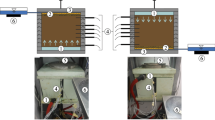This paper deals with a finite element analysis of heat transfer with phase change in frozen soil in terms of the transient temperature field and the thermally induced solid-solid phase transformations. By analyzing the shortcomings of the traditional finite element method in solving the phase change problem and the characteristics of the freezing process in frozen soil, the extended finite element method was proposed to solve the heat transfer problem with phase change for permafrost engineering. Taking a quadrilateral element as an example, the extended finite element method interpolating function and solution format of the temperature field with phase change was derived. According to studies on constructing and solving the level set function, building of the stiffness matrix, and the subdivision of the elements, a program for heat transfer with phase change was proposed. The numerical solution is in good agreement with the measured value.
Similar content being viewed by others
References
N. Moes, J. Dolbow, and T. Belytschko, “A finite element method for crack growth without remeshing,” Int. J. Numer. Methods Eng., 46, 131-150 (1999).
T. Belytschko and T. Black, “Elastic crack growth in finite elements with minimal remeshing,” Int. J. Numer. Methods Eng., 45, 601-620(1999).
C. Daux, N. Moes, J. Dolbow, N. Sukumar, and T. Belytschko, “Arbitrary branched and intersecting cracks with the extended finite element method,” Int. J. Numer. Methods Eng., 48, 1741-1760 (2000).
D. Motamedi and S. Mohammadi, “Fracture analysis of composites by time independent moving-crack orthotropic X-FEM,” Int. J. Mech. Sci., 54, 20-37 (2012).
L. Bouhala, Q. Shao, Y. Koutsawa, A. Younes, P. Nunez, A. Makradi, and S. Belouettar, “An X-FEM crack-tip enrichment for a crack terminating at a bi-material interface,” Eng. Fract. Mech., 102, 51-64(2013).
S. S. Hosseini, H. Bayesteh, and S. Mohammadi, “Thermo-mechanical X-FEM crack propagation analysis of functionally graded materials,” Mater. Sci. Eng. A, 561, 285-302 (2013).
J. He, J. Yang, Y. Wang, H. Waisman, and W. Zhang, “Probabilistic model updating for sizing of hole-edge crack using fiber bragg grating sensors and the high-order extended finite element method,” Sensors, 16, 1956(2016).
J. Chessa, P. Smolinski, and T. Belytschko, “The extended finite element method (X-FEM) for solidification problems,” Int. J. Numer. Methods Eng., 53, 1959-1977(2002).
Y. J. Choi, M. A. Hulsen, and H. E. H. Meijer, “Simulation of the flow of a viscoelastic fluid around a stationary cylinder using an extended finite element method,” Comput. Fluids, 57, 183-194(2012).
T. Q. N. Tran, H. P. Lee, and S. P. Lim, “Modelling porous structures by penalty approach in the extended finite element method,” Comput. Methods Biomech. Biomed. Eng., 16, 347-357(2013).
R. Merle and J. Dolbow, “Solving thermal and phase change problems with the extended finite element method,” Comput. Mech., 28, 339-350(2002).
H. Ji, D. Chopp, and J. E. Dolbow, “A hybrid extended finite element/level set method for modeling phase transformations,” Int. J. Numer. Methods Eng., 54, 1209-1233(2002).
L. Salvatori and N. Tosi, “Stefan problem through extended finite elements: review and further investigations,” Algorithms, 2, 1177-1220(2009).
M. K. Bernauer and R. Herzog, “Implementation of an X-FEM solver for the classical two-phase Stefan problem,” J. Sci. Comput., 52, 271-293(2012).
P. Diez, R. Cottereau, and S. Zlotnik, “A stable X-FEM formulation for multi-phase problems enforcing the accuracy of the fluxes through Lagrange multipliers,” Int. J. Numer. Methods Eng., 96, 303-322 (2013).
G. Ferte, P. Massin, and N. Moes, “Interface problems with quadratic X-FEM: design of a stable multiplier space and error analysis,” Int. J. Numer. Methods Eng., 100, 834-870(2014).
A. Cosimo, V. Fachinotti, and A. Cardona, “An enrichment scheme for solidification problems,” Comput. Mech., 52, 17-35(2013).
E. Benvenuti, G. Ventura, N. Ponara, and A. Tralli, “Variationally consistent extended FE model for 3D planar and curved imperfect interfaces,” Comput. Meth. Appl. Mech. Eng., 267, 434-457(2013).
J. Liu and Y. Tian, “Numerical studies for the thermal regime of a roadbed with insulation on permafrost,” Cold Reg. Sci. Tech., 35, 1-13 (2002).
A. Gholamzadehabolfazl, “A numerical study of a highway embankment on degrading permafrost,” M.Sc. thesis, The University of Manitoba, Canada (2015).
M. C. Alfaro, G. A. Ciro, K. J. Thiessen, and Tony Ng, “Case Study of Degrading Permafrost beneath a Road Embankment,” J. Cold Reg. Eng., 23, 93-111 (2009).
X. Kong, G. Dore, and F. Calmels, “Thermal modeling of heat balance through embankments in permafrost regions,” J. Cold Reg. Eng., 158, 117-127 (2018).
M. Zhang, Y. Lai, Z. Gao, and W. Yu, “Influence of boundary conditions on the cooling effect of crushed-rock embankment in permafrost regions of Qinghai-Tibetan Plateau,” Cold Reg. Sci. Tech., 44, 225-239 (2006).”
Author information
Authors and Affiliations
Corresponding author
Additional information
Translated from Osnovaniya, Fundamenty i Mekhanika Gruntov, No. 6, p. 31, November-December, 2020.
Rights and permissions
About this article
Cite this article
He, M., Yang, Q., Li, N. et al. An Extended Finite Element Method for Heat Transfer with Phase Change in Frozen Soil. Soil Mech Found Eng 57, 497–505 (2021). https://doi.org/10.1007/s11204-021-09698-z
Published:
Issue Date:
DOI: https://doi.org/10.1007/s11204-021-09698-z




